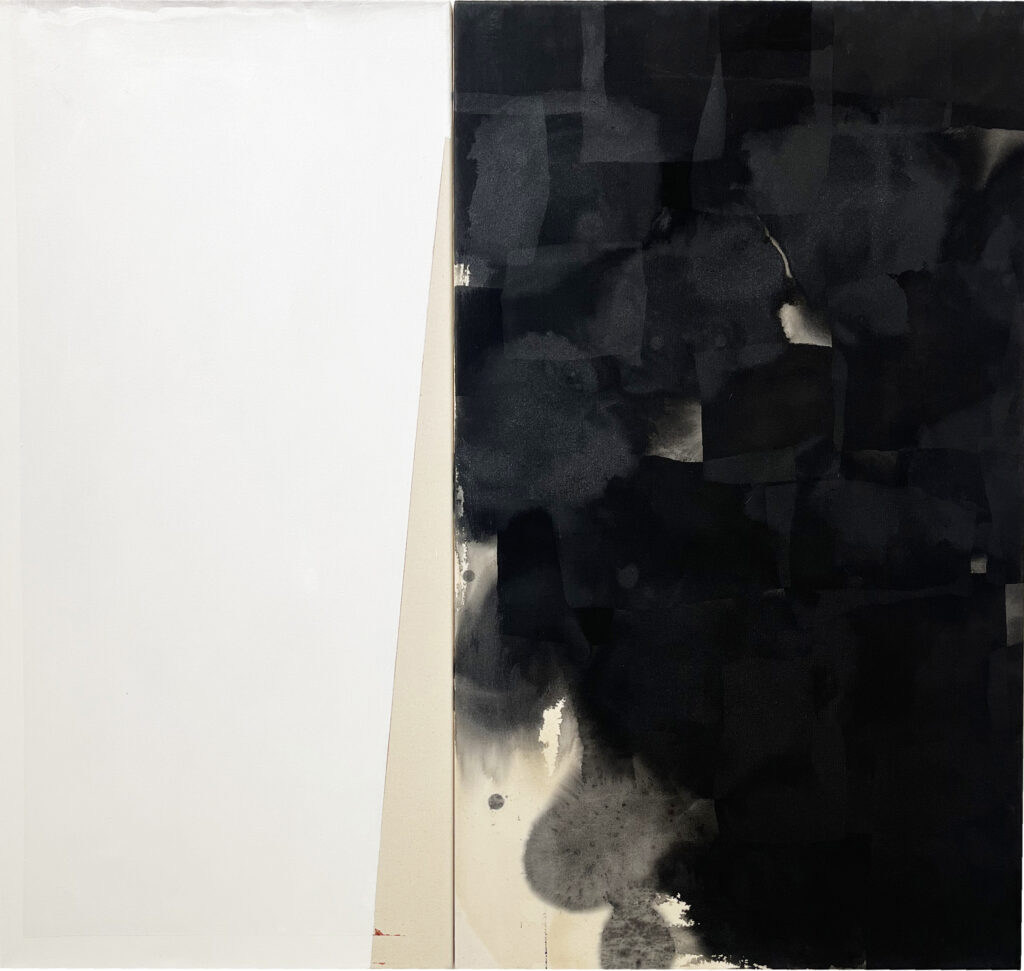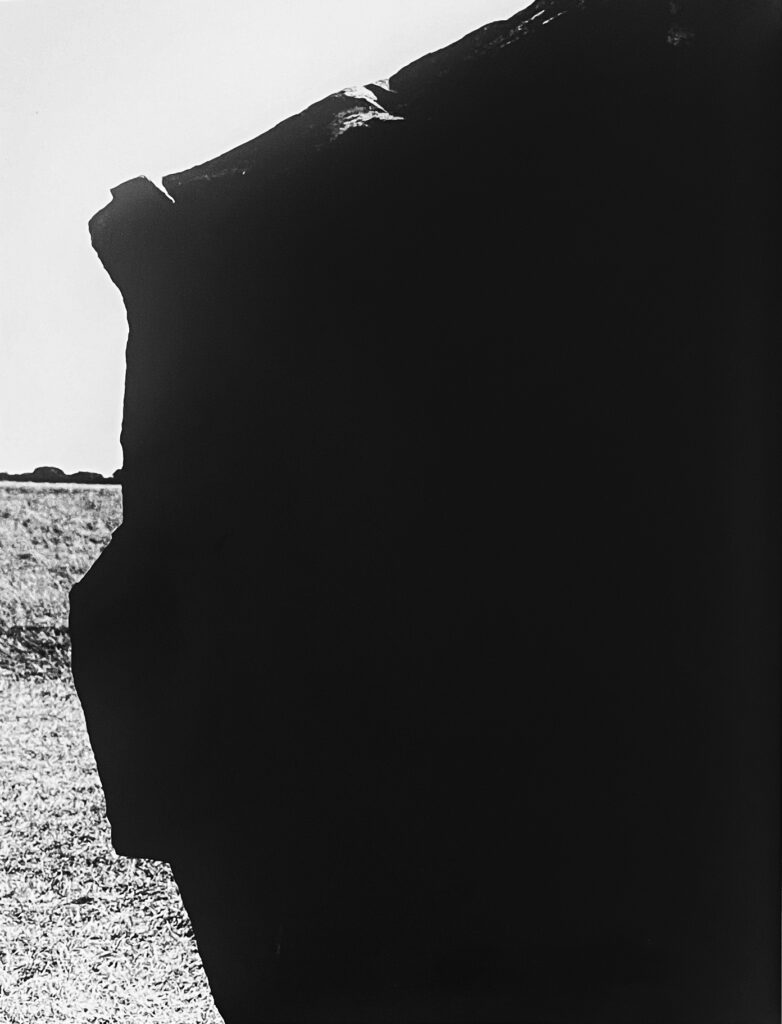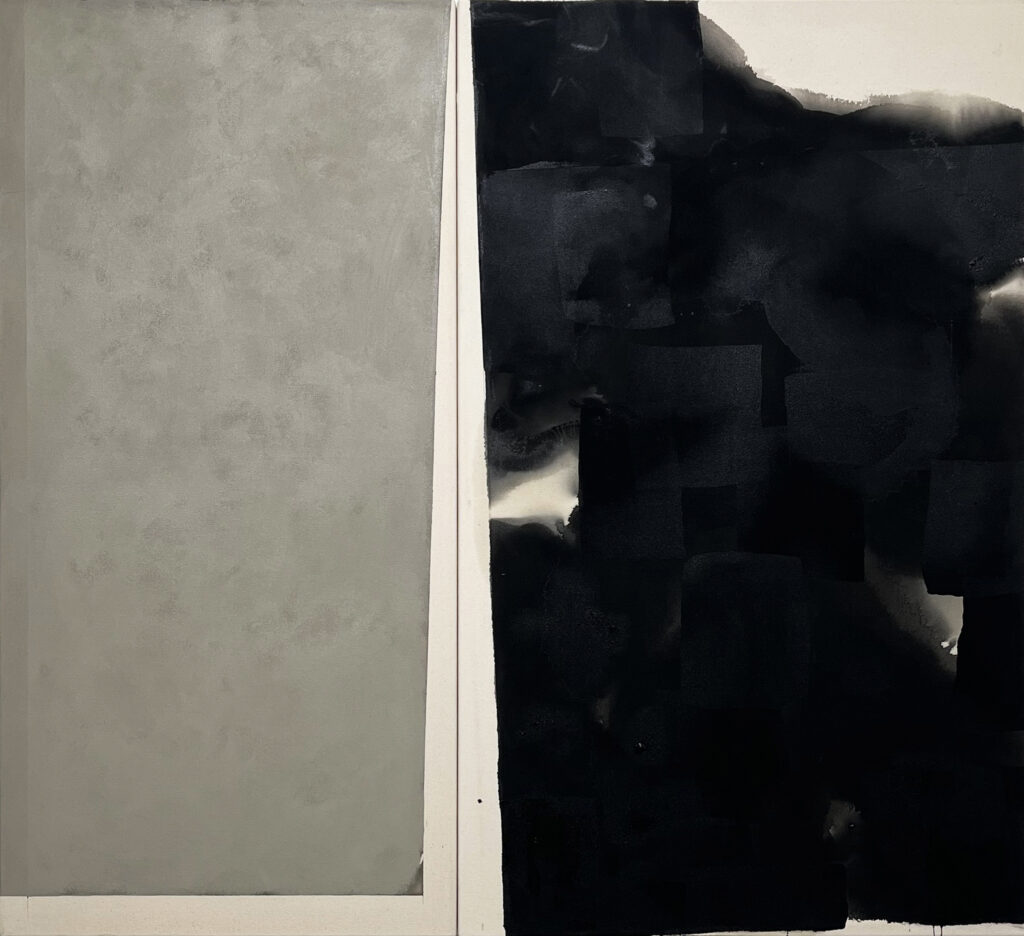Ian McKeever : Paintings from the ‘Henge’ series at Berg Contemporary, Reykjavik; ‘Against Architecture’ at TheGallery, the University of Bournemouth
Since the beginnings of abstraction, painting black paintings- that is, paintings that are mostly or entirely black- has been understood as staking a claim to a high seriousness of the most forbidding kind. Think of Kasimir Malevich’s iconic ‘Black Square’, or Robert Motherwell’s ‘Elegies to the Spanish Republic’; Clyfford Still’s towering crags and canyons of tarry, knifed-on pigment, or the ragged black bands and ‘zips’ of Barnett Newman’s ‘Stations of the Cross’; the mute blankness and finality of late-period Ad Reinhardt (famously dubbed the ‘Black Monk’ of Abstract Expressionism) or the drawn-out ‘suicide note’ of Mark Rothko’s last paintings. Black is the hallmark of a tragic sense of history, the harbinger of that history’s imminent end, and ultimately, for many, the agent of painting’s effacement of itself. Newman asserted that ‘tragedy demands black’; whilst Reinhardt claimed to be making ‘the last paintings anyone can make’.
Painting, though, has an awkward habit of breaking all rules laid down for it, and of defying all forecasts made on its behalf. A case in point: more than half a century after the apocalypse that Reinhardt ushered in, Berg Contemporary in Reykjavik has recently shown six of the thirty ‘Henge’ diptychs that Ian McKeever has painted since 2017, alongside a selection of the gouaches and prints that followed in the paintings’ wake; and whilst black, a great deal of black, and an emphatically black black at that, is the common denominator of each work, whether on canvas or paper, it’s nevertheless striking how unencumbered the work feels by all the heavy baggage that black has so often been asked to carry. McKeever’s concern is not so much with the end of painting as with (in a manner of speaking) both ends of painting: its two limit colours, white and black. He has spent a considerable amount of time over the last few decades exploring both of them, their physical properties as paint, their possibilities as meaning-makers, in groups of paintings that are made of either one or the other; and with the ‘Henge’ series, it doesn’t feel like overstating the case to say that he is taking black (or perhaps black is taking him?) to a new place in painting.
The initial impetus for the paintings was a set of black and white photographs McKeever made of the large standing stones at Avebury, in Wiltshire. The deep shadows and silhouettes of the stones, filling almost the whole image in each photograph, and the border of daylight playing over and around their looming contours, have found their way into the paintings’ stark oppositions: the black forms set askew within their panel, with a surround of raw canvas on two sides; the blackness of one panel against the unnameable warm grey or rusty orange-ochre of its twin; the way that one half of each diptych seems to stand still, whilst the other half seems to shift and stir. The photographs document a series of encounters; the paintings are encounters, between their two halves, whether black and colour, black and white, or (in the case of ‘Henge XXVII’ and ‘Henge XXXV’) black and black, and between the whole work and the viewer.
Solid black stares back; move slightly to either side, and it catches the light, flaring into a gleaming, silvery, segmented skin of accumulated layerings, and then back to black. These overlapping patchworks of black on black seem to be feeling their way into their own darkness, in much the same way that one might move through a corridor or hallway in total blackness, step by cautious step, hands outstretched, ‘seeing’ with the fingertips in the dark. Without recourse to ‘picturing’, or to objects, or to symbols of any kind, the paintings’ darkness offers up an experience of enveloping sensuousness- tenderness, even- as the eye acclimatises to shifting depths and pulses of flaring light, and to the extraordinary range of nuance coaxed from the dialogue across the divide between paired panels, where the paint stops short of the raw canvas edges in a pale penumbra of thinned staining, or in smoky billows, or in a hard, crenelated borderline.
Despite their densities of black, these paintings feel open, where so many monochromes feel as if they have slammed shut. Here, the formal and colouristic resources of abstract painting are not reduced, but concentrated; not as ends in themselves, but as the means by which to make the attempt, in McKeever’s own words, ‘to feel and sense things [one] cannot put an immediate form to.’ In each of the ‘Henges’, the emphasis falls differently, uniquely, between what the paintings reveal and what they seem to conceal, between the sheer, undeniable thereness of their painted surfaces, and felt presences, indistinct, intangible, yet tantalisingly close.

Installation view of ‘Ian McKeever: Paintings from the “Henge” series’ at Berg Contemporary, Reykjavik, 2023
Meanwhile, ‘Against Architecture’, McKeever’s 2017 installation at Matt’s Gallery, has, since the beginning of November, been given a new lease of life at the University of Bournemouth. The title, ‘Against Architecture’, refers to the entire display, but also to one of the two series of works, alongside ‘Eagduru’, that make up its contents. The works in the ‘Against Architecture’ series are assemblages of thin verticals, some topped or tailed (or both) by thin strips of painted ply; ‘Eagduru’ is a series of diptychs, that in size and proportions feel faintly reminiscent of the open spreads of a large book.
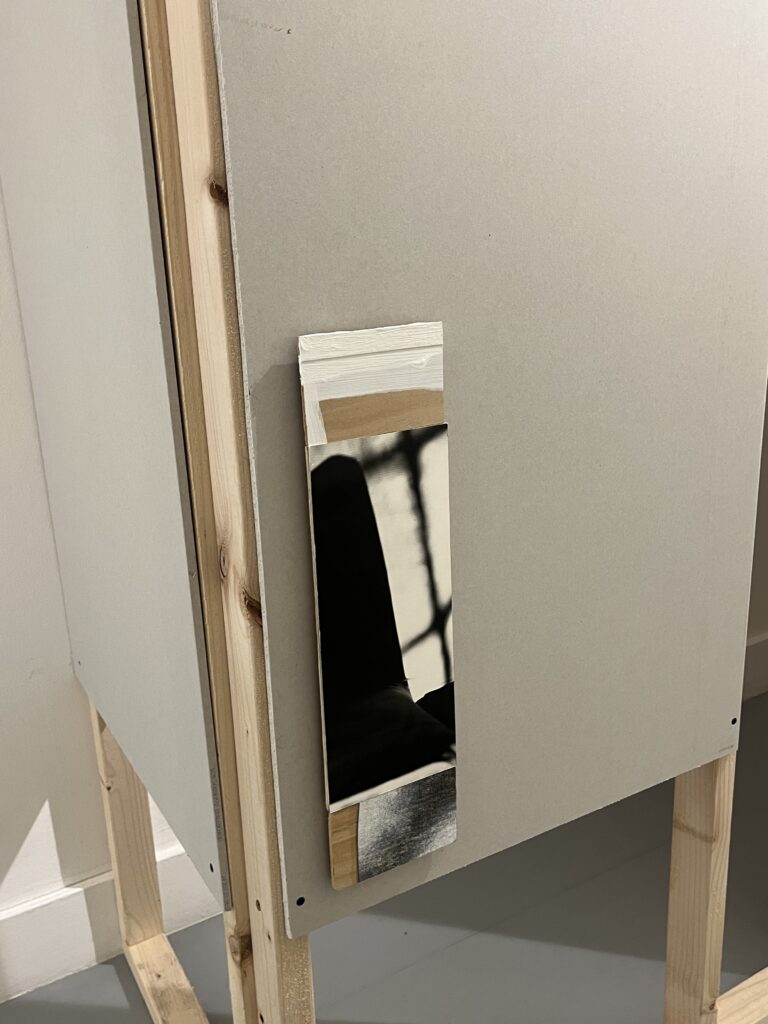
Installation view of ‘Ian McKeever: Against Architecture’ at TheGallery, University of Bournemouth, 2023, with ‘Against Architecture 17’ (2013), mixed media, 50 x 14cm
The diptychs are paired images, whilst the assemblages, despite their incorporation of thin bands of image-bearing offcuts of photographs and painted canvas, feel far more like constructed objects; the narrowness and verticality of the format draw attention away from what individual surfaces are, or what they show, and direct it towards a heightened awareness of the processes that went into the works’ making- the sorting through, selecting, slicing, mounting on plywood and fastening together of fragments of photographs and discarded paintings- and of the off-kilter, half-aligned asymmetries of their finished states. Despite their modest size, the ‘Against Architecture’ pieces are intensely, physically present; present enough to vie with the purpose-built supporting structure of two-by-twos of untreated timber and grey plasterboard panels with their manufacturer’s codes fully visible, and to enter into a teasing exchange with it. Work and wall seem to be leaking into each other, and taking on each other’s traits: the gaps between and around the works’ strips of painting and photograph allow the builder’s-yard matter-of-factness of bare ply to peek through, whilst the -at first- apparently artless carpentry of the installation that houses them generates a bewildering labyrinth of haphazard thresholds, gaps and apertures that echoes the works’ ambiguous solids and spaces.
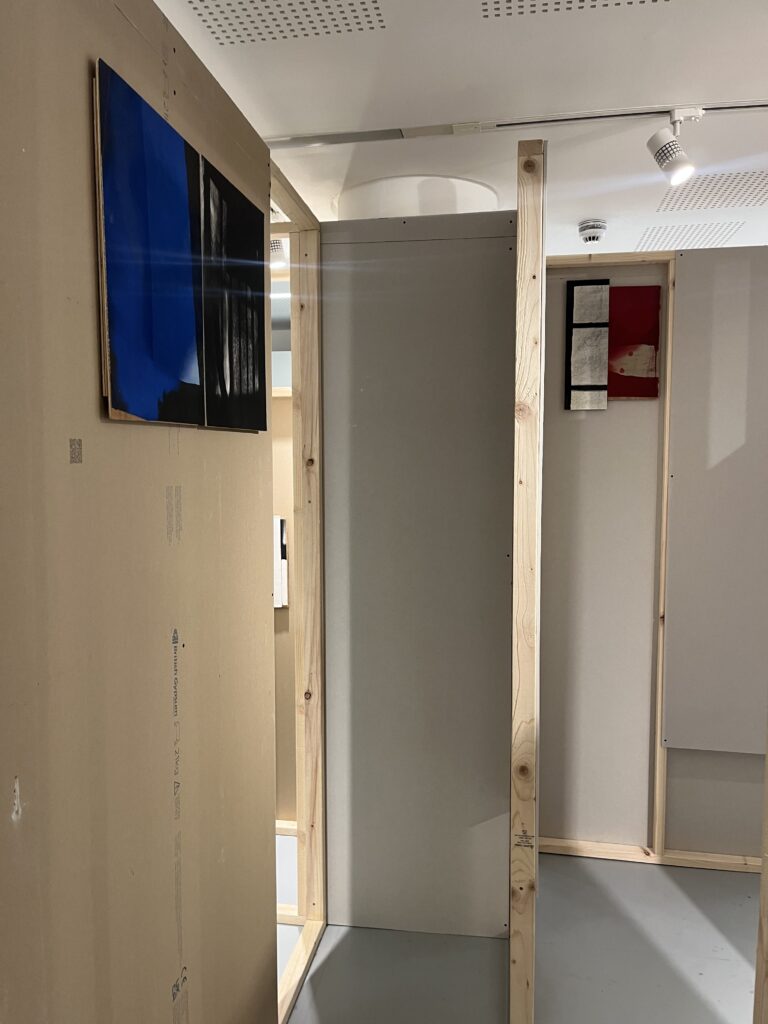
Installation view of ‘Ian McKeever: Against Architecture’ at TheGallery, University of Bournemouth, 2023, with (L to R): ‘Eagduru 8’ (2013), mixed media, 53 x 77cm, and ‘Against Architecture 1’ (2013), mixed media, 52 x 37cm

Installation view of ‘Ian McKeever: Against Architecture’ at TheGallery, University of Bournemouth, 2023, with ‘Eagduru 10’ (2013), mixed media, 56 x 69cm
McKeever has spoken about how it felt, in the exhibition’s first incarnation, as if there were a three-way conversation going on between the works, their scaffolding of timber and board, and the rough, undecorated interior walls of Matt’s Gallery; as opposed to here, where the immaculate, clean white lines of TheGallery, the University’s art space, seem to be standing back from the exchange, narrowing it down to ‘dialogue rather than trialogue’. That rings true: but any loss of the richness of the original experience feels fully compensated for by the sense of other dialogues within the dialogue, a call-and-response between the work being viewed and the works glimpsed off to the sides through framing ‘doorways’ and ‘windows’, between works hung high and low; and most affectingly, between the photographic and painted elements of individual pieces in both series. Since the constituent parts of the ‘Against Architecture’ pieces are small and drastically cropped, the sense of dialogue in them is fragmentary, fleeting and in many cases kinetic: in ‘Against Architecture 12’, for example, the curved strip of pasted red canvas and its answering curve of black photographic form seem to be speeding past each other in opposite directions. The‘Eagduru’ pieces, by contrast, are hushed and stilled between their two halves, and the obvious formal echoes (such as, for example, those between the plywood border of the grey paint on the left side of ‘Eagduru 21’ and the shadowline cast by the bedlinens in the photograph on its right; or between the spreading paint and spreading shadows of ‘Eagduru 8’) blur the distinctions between how both were formed, the one by the pooling and spreading of paint, the other by the instantaneous click of a shutter.
What we think we’re looking at conditions how we look at it; the way in which we look at a photograph differs from the way in which we look at a painting. To be unsure about which of the two mediums we’re actually seeing in these works- to have that moment of certainty postponed- is to see with fresh eyes, to notice how the photographic fragments feel saturated with the unfathomable slowness of what McKeever has called ‘the time of painting’, whilst the paint seems somehow caught mid-movement, as by a camera. It is also to be made suddenly, reflexively aware of ourselves in the act of looking, and of how conditional and contingent that act of looking really is.
‘Paintings from the “Henge” series’ came down earlier this month; “Against Architecture” is at TheGallery, the University of Bournemouth, until January 18th 2024.
Ian McKeever will be discussing ‘Against Architecture’ with Professor Paul Gough in TheGallery at 5pm on January 18th 2024.
Visit https://aub.ac.uk/latest/thegallerys-25-years-exhibition-showcase for further details about this event.
